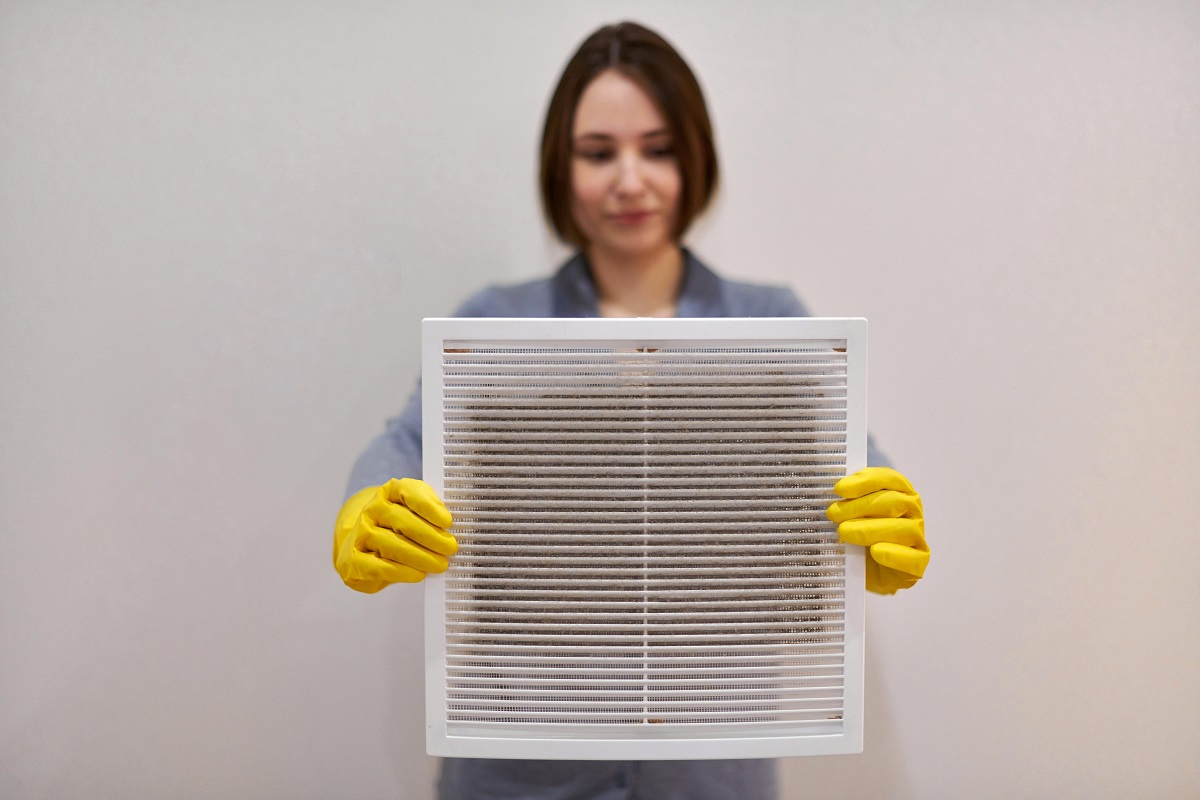How to Test for Mold in House: The Definitive Guide

Table of Contents
- Key Takeaways
- What Are the First Steps to Check for Mold in a House?
- What Are the Signs of Hidden Mold in Walls?
- Are Traditional Mold Testing Methods Reliable?
- Is There a Smarter, Non-Invasive Way to Assess Mold Risk?
- So, What Is the Best Way to Detect Mold Proactively?
- How Can I Ensure Long-Term Mold Prevention for My Property?
- Frequently Asked Questions (FAQ)
How Do You Test for Mold in a House? The Complete Guide
It’s a worry that can keep you up at night. You catch a faint, musty smell in the basement or notice a dark spot in the corner of the bathroom. Immediately, your mind starts to race. Is it mold? Could it be making my family sick? The uncertainty is often the worst part. You want a clear answer and a clear path forward. The question of how to test for mold in a house is a common one, and thankfully, getting a definitive answer is more accessible than ever.
The best method for checking for mold depends on your specific situation, your property, and what signs you are seeing. For a long time, the only options were unreliable do-it-yourself kits or expensive, disruptive professional inspections. But technology has created smarter, more effective options. This guide will walk you through every step, from the simple checks you can do right now to a revolutionary digital approach that gives you a complete picture of your home’s environmental health, helping you find peace of mind.
Key Takeaways
- Start with Your Senses: Your first line of defense is a simple visual and smell check. Walk through your home, look for visible signs of growth, and pay attention to any musty odors. But remember, the most dangerous mold problems are often the ones you can’t see.
- Know the Hidden Signs: If you have persistent musty smells with no obvious source, unexplained allergy-like symptoms, or a history of water damage, these are major signs of hidden mold in walls that demand a deeper investigation.
- Be Wary of DIY Kits: While affordable, DIY mold testing kit reviews consistently reveal that they are unreliable. They can't find the source of the mold and often give misleading results, leaving you exactly where you started.
- Pro Inspections Have Downsides: A traditional mold inspector can be thorough, but the process comes with a high professional mold inspection cost and often involves cutting into walls or ceilings.
- The Best Modern Method: The best way to detect mold risk today is by using new non-invasive mold detection methods. These approaches analyze your home’s unique data points to predict vulnerabilities before mold even has a chance to grow.
- The Nestwell Solution: Nestwell’s digital home environmental health assessment for mold performs a complete property mold risk assessment remotely. It provides a science-backed, personalized action plan without the high costs, delays, and disruption of older methods.
What Are the First Steps to Check for Mold in a House?
Before you spend any money or call in an expert, the first thing to do is a careful walkthrough of your property. Learning how to check for mold in a house begins with using your own eyes and nose. These senses are surprisingly effective at picking up the most common and obvious signs of a moisture problem, which is the root cause of all mold growth.
Think of yourself as a detective looking for clues. Grab a flashlight and dedicate some time to a slow, thorough inspection of key areas known for moisture issues. Don't rush this process; the more detailed you are, the better.
Use Your Eyes: A Visual Inspection Checklist
Mold can appear in many colors, including black, green, white, gray, or even orange. It can look like fuzzy patches, dark spots, or simple discoloration. Here are the most important places to look:
- Bathrooms and Kitchens: Check around sinks, faucets, and drains for any dark spots or slimy textures. Inspect the grout lines between tiles in your shower and bathtub. Look underneath sinks for any signs of past or present leaks, like water stains, warped cabinet wood, or peeling paint on the wall behind the pipes.
- Windows and Windowsills: Condensation on windows can drip down and create a perfect environment for mold growth on the sills and surrounding drywall. Look for black spots in the corners of the window frame or peeling paint on the wall beneath it.
- Basements and Crawl Spaces: These are prime areas for mold. Shine your flashlight along the base of concrete walls, looking for discoloration or powdery residue. Check wooden support beams and joists for dark staining. If you have any items stored in cardboard boxes, check them for musty smells or visible spots.
- Around Appliances: Inspect the areas around your washing machine, dishwasher, and refrigerator. Check the hoses for any slow drips. Pull refrigerators away from the wall to look for condensation or leaks from the ice maker line.
- Attics and Ceilings: Look for any staining or discoloration on your ceilings. This is often a sign of a roof leak. In the attic, check the underside of the roof sheathing for dark patches, especially around vents and chimneys.
Use Your Nose: Following the Scent
Sometimes, the first and only sign of a mold problem is a distinct smell. Mold gives off microbial volatile organic compounds (MVOCs), which create a persistent, unpleasant odor. If you notice a smell, don't ignore it, even if you can't see anything.
The smell is often described as musty, earthy, damp, or smelling like wet socks or rotting wood. The key is that the smell is persistent. If a room smells stuffy but airs out quickly, it might just be a lack of ventilation. But if the musty odor returns or is always present in a certain area, it’s a strong indicator that there is a hidden moisture source feeding mold growth somewhere nearby.
These initial checks are a great starting point. If you find visible mold or a strong, persistent smell, you know you have a problem. But what happens when you suspect an issue you can't see?
What Are the Signs of Hidden Mold in Walls?
One of the biggest fears for any property owner is the mold you can't see. Mold growing behind drywall, under flooring, or in ceiling cavities can go undetected for months or even years, silently damaging your property and potentially affecting your indoor air quality. Because it’s out of sight, you need to learn to recognize the other clues it leaves behind. The signs of hidden mold in walls are often subtle, but they tell an important story about your home's health.
If your initial sensory check didn't reveal any visible growth but you still have a nagging feeling that something is wrong, pay close attention to these critical warning signs. They are your body's and your building's ways of telling you there is a hidden problem that needs attention.
- A Persistent Musty Odor with No Visible Source: This is the number one sign of hidden mold. If you constantly smell that damp, earthy odor in a specific room or area of your home but have searched high and low without finding any visible mold, it’s highly likely that the source is behind a wall, under the carpet, or above the ceiling. The smell is created by mold as it grows and digests materials, and those gases can easily pass through porous materials like drywall.
- Unexplained Health Symptoms: Your body can be a very sensitive mold detector. If you or your family members are experiencing chronic allergy-like symptoms that don't seem to have a clear cause, it could be related to indoor air quality. These symptoms may include a runny nose, constant sneezing, itchy or watery eyes, a sore throat, or skin irritation. A key clue is if these symptoms get better when you leave the house for an extended period, like going to work or on vacation, and then return shortly after you come back home.
- Visible Wall or Ceiling Damage: Even if you can't see the mold itself, you can often see the damage the moisture is causing to the wall in front of it. Look for bubbling, cracking, or peeling paint. This happens when moisture from behind soaks into the drywall, causing the paint layer to lose adhesion. You might also notice discoloration, appearing as faint yellow or brown water stains. In more advanced cases, the drywall itself may look warped, bowed, or feel soft and spongy to the touch.
- Condensation Buildup: Frequent condensation on surfaces like windows, pipes, or even walls is a big red flag. While some morning condensation on windows can be normal, excessive moisture that lingers all day suggests that the humidity inside your home is too high. High humidity is the fuel that mold needs to grow. This moisture can be absorbed by walls and insulation, creating the perfect hidden breeding ground for mold colonies.
If you recognize any of these signs, you are right to be concerned. It's a clear signal that a deeper investigation is necessary. Many people's next thought is to grab a test kit from the hardware store or call an inspector, but as we'll see, these traditional approaches have serious flaws.
Are Traditional Mold Testing Methods Reliable?
When you suspect hidden mold, you want a reliable answer, and you want it fast. For decades, the industry has offered two main paths: do-it-yourself (DIY) test kits and professional on-site inspections. While both are intended to provide clarity, they often create more confusion, expense, and frustration than they solve. Understanding the limitations of these old-school methods is key to choosing a truly effective modern solution.
Before you invest your time and money, it's crucial to look critically at what these traditional options actually deliver and, more importantly, what they don't.
What Do DIY Mold Testing Kit Reviews Actually Say?
The appeal of DIY mold tests is obvious. They are cheap, easily available at any big-box hardware store, and seem simple to use. The packaging promises to give you an answer about the mold in your home. However, if you dig into unbiased DIY mold testing kit reviews and expert opinions from building scientists, a very different picture emerges. These kits are widely considered to be unreliable and often a waste of money.
Here's why these kits fail to deliver meaningful results:
- They Don't Find the Source: The most common type of kit involves a petri dish that you leave open to the air for a period of time. It will almost certainly grow mold. Why? Because mold spores are a natural part of our environment and are always present in the air, both indoors and out. A positive result doesn't tell you if you have a dangerous mold colony in your wall or just normal background spores. It offers zero information about the location or severity of the problem.
- They Produce False Positives and Negatives: Because mold spores are everywhere, an open petri dish can easily give you a "false positive," causing unnecessary panic and expense. Conversely, a kit could fail to capture spores from a serious, hidden mold problem, giving you a dangerous "false negative" and a false sense of security.
- They Don't Quantify the Problem: A professional assessment measures the concentration and types of mold spores to determine if the indoor environment has an elevated level compared to the outdoors. A DIY kit cannot do this. It can't tell you if you have a small, harmless amount of mold or a massive, hazardous infestation.
- They Offer No Action Plan: The worst part is that even if a DIY kit indicates a problem, it leaves you with no actionable information. You still don't know where the mold is, what's causing it, or what to do about it. You're back at square one, but now you're out the cost of the kit and are likely more anxious than before.
What Is the Typical Professional Mold Inspection Cost?
Given the unreliability of DIY kits, the next logical step seems to be calling a professional. A certified mold inspector will come to your property to perform a visual inspection and conduct indoor air quality testing for mold. This approach is certainly more thorough than a DIY kit, but it comes with its own significant set of drawbacks.
The primary barrier for most people is the professional mold inspection cost. A basic assessment, which includes a visual inspection and a few air or surface samples sent to a lab, typically starts between $300 and $600. For larger properties or more complex issues requiring more samples, the cost can easily climb to $1,000 or more. It is critical to understand that this price is just for the testing and the report. It does not include the cost of fixing the problem, which can be thousands of dollars.
Beyond the high cost, consider these other negatives:
- It's Invasive: To find hidden mold, inspectors often have to do destructive testing. This may involve cutting holes in your drywall, pulling up carpets, or removing baseboards to take samples from behind surfaces. This causes damage that you will then be responsible for repairing.
- It's Slow and Inconvenient: You have to schedule a time for the inspector to visit, which can take days or weeks. After the on-site visit, the samples must be shipped to a lab for analysis, which can add another week or more to the process. The entire time, you are left waiting and worrying.
- Reports Can Be Confusing: The lab report you receive is often filled with scientific jargon, spore counts, and mold species names that are difficult for the average homeowner to understand. It may confirm you have mold, but it might not clearly identify the root cause or provide a simple, step-by-step plan to fix it.
These traditional methods are reactive. They are designed to find mold that is already growing. But what if there was a better way to get ahead of the problem?
Is There a Smarter, Non-Invasive Way to Assess Mold Risk?
Yes. The future of home health is not about waiting for a problem to appear and then reacting to it. It's about proactively understanding your property's unique vulnerabilities and addressing them before they lead to mold growth. Technology has enabled powerful non-invasive mold detection methods that analyze your home as a complete system, moving beyond simple spot-testing to provide a truly holistic picture of its environmental health.
Nestwell is at the forefront of this modern approach. Instead of guessing with a petri dish or cutting holes in your walls, Nestwell performs a digital home environmental health assessment for mold. This revolutionary process uses data and science to identify the *root causes* of mold risk, all without ever needing to physically enter your home. It’s a smarter, faster, and more affordable way to get the answers you need.
Here is how this advanced digital assessment works:
- Comprehensive Data Collection: The process starts with you. Through a simple, guided online platform, you provide key details about your property. This isn't just about the address; it includes crucial information like the year it was built, the type of foundation (e.g., slab, crawl space, basement), the kind of heating and cooling system you have, the materials used in its construction, and any known history of leaks or water damage. This creates a unique digital fingerprint of your home.
- Cross-Referenced Analysis: This is where the power of big data comes into play. Nestwell cross-references your property's unique fingerprint with massive, authoritative scientific and environmental databases. This includes decades of localized climate data (humidity levels, rainfall patterns), regional soil and groundwater conditions, common building vulnerabilities for homes of a certain age and style in your area, and much more. This step connects the dots between your specific home and its surrounding environment.
- Advanced Risk Assessment: Finally, Nestwell’s proprietary algorithm analyzes all of this combined data to conduct a complete property mold risk assessment. It doesn't just look for existing mold; it looks for the *conditions* that allow mold to grow. The system can identify high-risk patterns, such as a foundation type that is vulnerable to moisture intrusion in your specific soil type, or a ventilation system that is inadequate for the high humidity levels in your region.
This innovative, data-driven method provides a complete overview of your home's health profile. Because the entire process is digital, it can be completed quickly and remotely, giving you a comprehensive, science-backed report without a single invasive test or the high cost of a traditional inspection.
So, What Is the Best Way to Detect Mold Proactively?
After reviewing the old methods and exploring new technology, it becomes clear: the best way to detect mold is not to wait until it's a visible, smelly problem that requires costly remediation. The best approach is to proactively understand and eliminate the risks that lead to mold growth in the first place. Prevention is always more effective and less expensive than a cure.
Instead of just performing a simple test, this modern approach gives you a complete environmental health game plan for your property. It shifts the focus from reactive detection to proactive management. This is the core of the Nestwell philosophy. We transform complex data into a clear, actionable strategy that empowers you to create a healthier living environment.
Here is what you receive from a Nestwell assessment, which goes far beyond what traditional indoor air quality testing for mold can offer:
- Your Healthy Home Score: We distill all the complex data points—dozens of them, from your roof to your foundation—into one simple, easy-to-understand score. This score instantly benchmarks your property's overall environmental health. You can see at a glance how your home stacks up and track your progress as you make improvements. It takes the guesswork out of understanding your risk level.
- A Detailed Home Health Report: This is the heart of your assessment. The report provides a room-by-room, system-by-system breakdown of your property’s specific vulnerabilities. It moves beyond generic advice and pinpoints the exact issues your home faces. For example, it might identify poor attic ventilation that could lead to wintertime condensation, a negative grade around your foundation that directs water toward your basement, or an HVAC system that is prone to creating high humidity. It connects the "what" (the risk) with the "why" (the root cause).
- A Personalized Action Plan: Knowledge is only powerful when you can act on it. Your report comes with a prioritized, science-backed action plan. It provides clear, step-by-step recommendations tailored specifically to your property's issues. The steps are broken down into simple, manageable tasks, from DIY improvements like adjusting gutter downspouts or improving bathroom ventilation, to larger projects that may require a professional. This plan gives you the exact blueprint you need to mitigate risks and raise your Healthy Home Score.
This comprehensive, data-driven solution represents the evolution of home health management. It's no longer just about asking, "Do I have mold?" It's about getting the answers to the more important questions: "Why might I be at risk for mold, and what is the most effective way for me to prevent it?"
How Can I Ensure Long-Term Mold Prevention for My Property?
A one-time test only gives you a snapshot in time. True peace of mind comes from building a long-term strategy for environmental health that protects your investment, enhances its value, and ensures a safe environment for anyone living or working inside. Shifting your mindset from a single reactive test to ongoing proactive management is the key to lasting success.
This is especially critical for B2B professionals, including property managers, real estate investors, and developers. For you, a property is more than just a home; it's a valuable asset. The presence of mold or even the risk of it can lead to decreased property values, unhappy tenants, potential legal liabilities, and costly, reputation-damaging repairs. Proactively managing environmental health is one of the smartest investments you can make.
An ongoing commitment to this proactive approach culminates in a powerful new asset: a healthy home certification for mold prevention. This certification, backed by Nestwell's scientific data and analysis, serves as a tangible signal to the market that a property meets a high standard of environmental health.
This certification delivers immense value across the real estate landscape:
- A Powerful Market Differentiator: In a crowded rental or sales market, a certified healthy home stands out. It's a premium feature that attracts health-conscious tenants and buyers who are willing to pay more for the assurance of a safe, clean living environment. It immediately answers unspoken questions about air quality and building integrity, giving you a significant competitive edge.
- Reduced Liability and Risk: For property managers and owners, demonstrating documented due diligence in maintaining a healthy environment is a powerful risk mitigation tool. By proactively identifying and addressing mold risks based on scientific data, you dramatically reduce the likelihood of tenant complaints, health-related disputes, and potential litigation. It shows you are a responsible, forward-thinking landlord.
- Enhanced Asset Protection and Value: Mold is a physical threat to a building. It rots wood, compromises drywall, and can lead to structural issues over time. By addressing the root causes of moisture before mold takes hold, you are protecting the physical integrity of your asset. This proactive maintenance prevents small issues from becoming catastrophic failures, preserving and even increasing the long-term value of your property portfolio.
Ultimately, Nestwell empowers you to move from a position of worrying about potential mold issues to taking confident, proactive control. You can stop managing crises and start managing your property's environmental health as a core component of its value, ensuring it remains a safe and desirable asset for years to come.
Frequently Asked Questions (FAQ)
Q: What is the most reliable way to check for mold in my house?
A: While a traditional professional inspection can confirm the presence of active mold, a data-driven property mold risk assessment from Nestwell is the most reliable way to *proactively* manage your home's health. It goes beyond a simple "yes" or "no" to identify your home’s underlying vulnerabilities to moisture and mold, allowing you to fix the root causes and prevent problems before they even start.
Q: How much does a professional mold inspection cost?
A: The average professional mold inspection cost for an on-site visit and lab sampling is typically between $300 and $1,000, and that price only covers the initial assessment, not any repairs. Nestwell provides a more comprehensive digital report, a personalized action plan, and a Healthy Home Score for a fraction of that cost, with no scheduling hassles or invasive procedures.
Q: Are a[re DIY mold tests accurate](https://basementwaterproofingscientists.com/best-mold-test/)?
A: According to a vast number of DIY mold testing kit reviews and expert opinions from building scientists, these tests are generally not considered accurate or reliable for making important decisions. They cannot pinpoint the location or severity of a mold problem and often produce misleading results that cause more confusion and anxiety, making them an ineffective tool for a serious concern.
Q: How is Nestwell different from standard indoor air quality testing for mold?
A: Standard air quality tests only provide a brief snapshot of the contaminants in the air at one specific moment in time. Nestwell’s home environmental health assessment for mold is a superior, holistic non-invasive mold detection method. It analyzes your property’s unique structure, its mechanical systems, and its local environment to identify the *root cause* of mold risk, providing you with a complete and actionable plan for long-term prevention.






